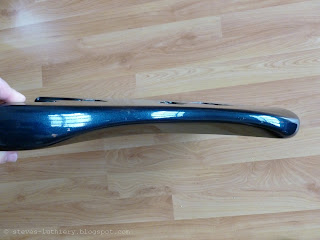Since I don't have much to post about while I'm waiting to start sanding down the body, I've decided to post some info about what I'm thinking of doing in order to cut down the weight of the body. Each idea has its pros and cons (the cons often related to the potential problems of woodworking with plywood!), and I may end up with some compromise between more than one of them. So, in no particular order...
1) Simply make the body thinner. Shave a thin layer of wood from the back of the body, possibly even a whole "ply" of the plywood which would make it easier to achieve a flat, consistent-thickness result. Like most of these options though, I'm not sure how the plywood will react to being planed/carved - I don't want it splintering everywhere, although that may be unavoidable regardless of what I do! Also I wouldn't be able to take much off without risking a reduction in the structural integrity of the bass as a whole once I get a neck on it and it's under tension from the strings. Another consideration is the hole for the jack and the strap button holes, as these would all no longer be exactly centered within the thickness of the body - especially a consideration for the jack. Lastly, the cover for the electrics cavity is neatly recessed into the body, so I'd have to re-do that recessing once I'm done, while still retaining the depth of the cavity that's needed to actually house everything. Tricky.
2) Trim down the shape of the body. Remove a little wood most of the way round, while still keeping the basic body shape - a good example of this is the Warmoth "Dinky P" body shape, for which they have an excellent little diagram showing the difference between a standard Precision-style body and their "dinky" version. Possibly quite tricky from a woodworking point of view, and I'd have to be quite careful not to end up with something bizarre-looking! Strap buttons are again a consideration, especially the one on the top "horn" of the body. Also the body has slightly carved/curved edges all the way round which I'd have to re-create once I'd cut the shape down, as the bridge end of the body would probably remain pretty much as is, so I'd have to keep that carved edge consistent all round.
3) Deeper arm-cut. The rib-cut on it is already pretty deep, but the arm cut isn't at all, so although it won't remove a lot of wood this is a pretty obvious way to gain a bit.
4) Cavities. Basically create one or more cavities in the body. A simple way to remove sheer bulk of wood, but one I'm reluctant to go for since it'd be risky for the structural integrity of the body, for the resonance of it (yes, I know it's only plywood!) and also from the point of view of the balance of it. I'm also sure that adding a laminate to cover the cavities would be beyond my woodworking capabilities, and I'm not too sure how exposed cavities would look even on the back! Some level of contouring of the back of the body (rather than blocky cavities) may be a possibility though, although it would probably look rather odd.
5) "Carved-top" look. Enhance the carved edges of the body from the small curve that's already there into something deeper and more akin to the PRS-style "carved-top" type of guitar. Probably beyond my woodworking skills, as it'd be difficult to achieve a result that's consistent and looks good all the way round a very curved shape. Also not much could be done behind the bridge as there's not a lot of wood to spare back there.
6) Drastic change in body shape. For example removing and rounding off the lower "horn", like with a Fender Jaguar. A risky strategy due the possibility of ending up with something that looks, well, ridiculous :-)
There are probably other options too - any suggestions and comments would be gratefully received, so please feel free to add them using the comments functionality below this post!


One option might be to bin the body and replace it with a lightweight one, but then you're getting into a "Trigger's broom" situation.
ReplyDeleteIndeed. Or I could buy a new bass, but that wouldn't be as much fun, would it?
ReplyDelete